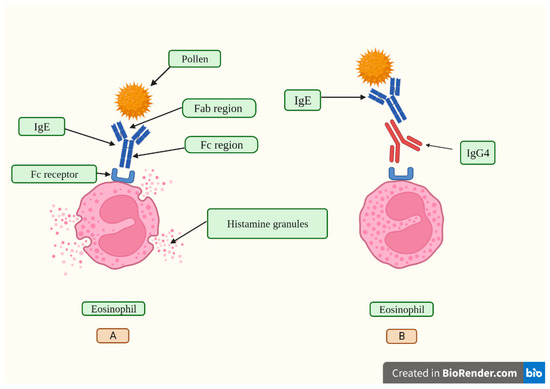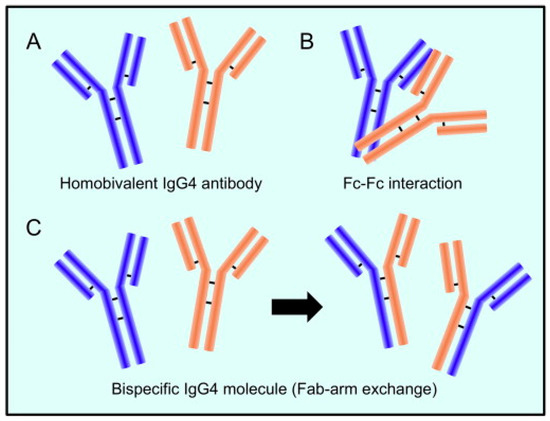ブログ総もくじ 伏見啓明整形外科公式サイト Coロナ関連記事目次 今、電子カルテがあぶない 個人情報談義 目次
https://www.mdpi.com/2076-393X/11/5/991
2. Characteristics of the Unusual IgG4 Antibody
2. 特異なIgG4抗体の特徴
Several
immunoglobulin classes and subclasses that constitute the antibody
immune arsenal, including IgA, IgE, IgM, and IgG, are essentially
identified by the structure of their heavy chain constant region.
IgA、IgE、IgM、IgGなど、抗体免疫アーセナル(兵器庫)を構成するいくつかの免疫グロブリンのクラスおよびサブクラスは、基本的にその重鎖定数領域の構造によって識別される。
ar・se・nal | ɑ́ːrs(ə)n(ə)l | 名詞C1 兵器[軍事品]の蓄え. 2 兵器(倉)庫, 兵器廠(しょう); 兵器工場. 3 〖通例単数形で〗(一般に)蓄え, 在庫; (研究などの)集積.
Human
immunoglobulins G (IgG) are divided into four subcategories based on the
immunogenicity of their heavy chains (IgGl, IgG2, IgG3, and IgG4) [32,33,34].
ヒト免疫グロブリンG(IgG)は、その重鎖の免疫原性に基づいて4つのサブカテゴリー(IgGl、IgG2、IgG3、およびIgG4)に分類される[32,33,34]。
Immunoglobulin subclasses differ in their basic physiologic regulation,
localization throughout the organism, and engagement with receptors on
immune system effector cells [35].
免疫グロブリンのサブクラスは、その基本的な生理学的調節、生体全体への局在化、免疫系エフェクター細胞上の受容体との関与において異なっている [35] 。
IgG4, the less prevalent subclass, is found in serum at mean values of 0.35–0.51 mg/mL [36], while the levels of IgG1, the most prevalent subclass, fluctuate between 5 and 12 mg/mL [37].
最も一般的なサブクラスであるIgG1の濃度が5~12mg/mLの間で変動しているのに対して、あまり一般的でないサブクラスであるIgG4は、血清中に0.35~0.51mg/mLの平均値で存在する [36]。
Due to its unusual biological characteristics and deficiency of
effector functions, such as the ability to destroy infected cells
through the activation of the complement system or using antibodies,
IgG4 has been referred to as an unusual antibody by not adhering to the
accepted theory of antibody structure and function [38,39].
IgG4は、その特異な生物学的特性と、補体系の活性化や抗体を用いて感染細胞を破壊する能力などのエフェクター機能の欠乏から、抗体の構造と機能に関する通説に従わない、特異な抗体と呼ばれてきた[38,39]。
The
mechanism behind the reaction involving the replacement of one half of
an antibody with another, also known as Fab arm exchange and specific to
IgG4 antibodies, has been elucidated over the past twenty years [40].
IgG4抗体に特異的なFabアーム交換とも呼ばれる、抗体の半分が別の半分に置き換わる反応の背後にあるメカニズムは、過去20年にわたって解明されてきた[40]。
The heavy chains can dissociate and then recombine arbitrarily due to
the enhanced propensity of the natural IgG4 joint disulfide bonds to
reduction, resulting in a heterogeneous group of IgG4 molecules with
random heavy-chain and light-chain couples (Figure 1) [40].
重鎖は、天然のIgG4結合のジスルフィド結合が還元されやすいため、任意に解離、再結合することができ、その結果、重鎖と軽鎖がランダムに結合した不均一なIgG4分子群になる(図1)[40]。
Figure 1.
IgG4 antibody has a distinctive structure.
図1. IgG4抗体は特徴的な構造を持つ。
(A). Two heavy chains and two light chains make up the IgG4 antibody.
(A). IgG4抗体を構成する2本の重鎖と2本の軽鎖。
(B). The Fc fragment of one IgG4 molecule can react with the Fc fragment of another.
(B). あるIgG4分子のFcフラグメントは、別のIgG4分子のFcフラグメントと反応することができる。
(C).
When half-molecules are exchanged (called a Fab-arm interchange), IgG4
combines two distinct specificities into a unique molecule (bispecific
antibody).
(C). 半分子が交換されると(Fab-アーム交換と呼ばれる)、IgG4は2つの異なる特異性をユニークな分子に結合する(二重特異性抗体)。
Reproduced from [41].
This is an open-access article distributed under the terms of the
Creative Commons CC-BY license, which permits unrestricted use,
distribution, and reproduction in any medium, provided the original work
is properly cited.
41]より転載。この記事は、Creative Commons CC-BYライセンスの条件の下で配布されているオープンアクセス記事であり、原著が適切に引用されていることを条件に、いかなる媒体においても無制限の使用、配布、複製が許可されている。
The majority of IgG4 molecules will have two
distinct Fab arms because of the half-antibody exchange, making them
“bi-specific” and operationally univalent for a particular antigen.
IgG4分子の大半は、半抗体交換により2つの異なるFabアームを有し、特定の抗原に対して「二重特異的」かつ操作上一価となる。
As a
result, far from the other IgG subclasses, IgG4 antibodies in
circulation are unable to form immunological complexes with antigens.
その結果、他のIgGサブクラスとは異なり、IgG4抗体は抗原と免疫複合体を形成することができない。
IgG4 antibodies have a limited theoretical potential for immunological
activation due to their weak affinity for C1q and Fc receptors.
IgG4抗体は、C1qおよびFcレセプターに対する親和性が弱いため、免疫学的活性化の理論的可能性は限られている。
The
production of immune complexes stimulates the complement system and the
action of immune effector cells.
免疫複合体の産生は、補体系と免疫効果細胞を刺激する。
Furthermore, IgG4 antibodies may be
able to block the inflammatory effects of IgG1 or IgE antibodies by
dislodging the binding of those with comparable specificities.
さらに、IgG4抗体は、同等の特異性を持つIgG1抗体やIgE抗体の結合をはずすことで、IgG1抗体やIgE抗体の炎症作用を阻害することができるかもしれない。
The
anti-inflammatory characteristic may offer insight into another
important fact that IgG4 antibodies are typically formed after prolonged
contact with an allergen, hence reducing the level of chronic
inflammation [28].
この抗炎症特性は、IgG4抗体は通常、アレルゲンと長時間接触した後に形成されるため、慢性炎症のレベルを低下させるというもう一つの重要な事実を示唆しているかもしれない[28]。
The
designation “IgG4-related systemic disease” refers to several clinical
manifestations that were formerly thought to be completely distinct
diseases.
IgG4関連全身性疾患」という呼称は、以前は全く別の疾患であると考えられていたいくつかの臨床症状を指す。
The list of organs linked to this illness is continuously
expanding.
この病気と関連する臓器のリストは増え続けている。
Regardless of the organ involved, tissue biopsies show
significant histological similarities.
関係する臓器にかかわらず、組織生検は組織学的に大きな類似性を示す。
However, there are slight
variations between organs as well.
しかし、臓器間でも若干の違いがある。
The hallmark pathology findings
include widespread fibrosis, numerous IgG4-positive plasma cells, and
disperse lympho-plasmacytoid infiltrates [42].
特徴的な病理所見には、広範な線維化、多数のIgG4陽性形質細胞、および分散したリンパ形質細胞浸潤が含まれる [42]。
特徴的な病理所見には、広範な線維化、多数のIgG4陽性形質細胞、および分散したリンパ形質細胞浸潤が含まれる [42]。
2.1. IgG4: A Protective or Pathogenic Antibody?
2.1. IgG4:防御抗体か病原性抗体か?
IgG4′s reputation as a “blocking antibody” stems from its diminished capacity to elicit immune system effector reactions [43,44].
IgG4が「ブロッキング抗体」であるという評判は、免疫系のエフェクター反応を引き起こす能力が低下していることに由来する [43,44] 。
This implies that there will only be a minimal immune response when IgG4 interacts with molecules [45].
このことは、IgG4が分子と相互作用しても、最小限の免疫反応しか起こらないことを意味している [45]。
An IgG4 response can be either pathogenic or protective, depending on
the situation.
IgG4の反応は、状況に応じて、病原性にも防御性にもなる。
For instance, IgG4 is frequently referred to as a
safeguarding blocking antibody because it can suppress or halt
inflammation by competing with inflammatory IgE for antigen binding in
the case of allergies and infections with helminth and filarial
parasites.
例えば、IgG4は、アレルギーや蠕虫およびフィラリア寄生虫による感染症の場合、抗原結合をめぐって炎症性IgEと競合することにより、炎症を抑制または停止させることができるため、保護的ブロック抗体と呼ばれることが多い。
In contrast, IgG4 can lead to serious illness in several
autoimmune disorders [46] as well as cancer [47,48].
対照的に、IgG4はいくつかの自己免疫疾患[46]や癌[47,48]において重篤な病気を引き起こす可能性がある。
Its bi-functionality will be thoroughly examined in the next subsections.
IgG4の二重機能性については、次の章で詳しく説明する。
IgG4の二重機能性については、次の章で詳しく説明する。
2.1.1. Protective Role of IgG4 in Allergy Immunotherapy
2.1.1. アレルギー免疫療法におけるIgG4の保護的役割
IgG4′s
lack of effector action and the phenomena of half-antibody interchange
create complicated considerations about whether these antibodies are
harmful or whether they act as a counter-regulatory reaction to an
enduring immunologic illness [40].
IgG4のエフェクター作用の欠如と半抗体の交換現象は、これらの抗体が有害であるのか、あるいは永続的な免疫学的疾患に対するカウンターレギュラトリー反応として作用するのかについて、複雑な考察を生む [40] 。
High concentrations of antigen-specific IgG4 are linked to satisfactory
results in allergen-specific immunotherapy by inhibiting immunoglobulin
E (IgE)-mediated effects (Figure 2), according to published studies [49,50].
高濃度の抗原特異的IgG4は、免疫グロブリンE(IgE)媒介作用を阻害することで、アレルゲン特異的免疫療法において満足のいく結果をもたらすと発表されている(図2)[49,50]。
In various aspects, developing a tolerance to allergens is an essential
step in the development of a strong immune system.
様々な側面から、アレルゲンに対する耐性を発達させることは、強力な免疫系の発達に不可欠なステップである。
Hence, to develop
prolonged desensitization against allergens, pathways involving modified
allergen-specific memory T- and B-cell responses that lead to
immunological tolerance are utilized [50,51,52].
したがって、アレルゲンに対する減感作を長期化させるためには、免疫学的寛容につながるアレルゲン特異的なメモリーT細胞およびB細胞応答の改変を伴う経路が利用される [50,51,52]。

Figure 2.
In (A), a pollen grain is recognized through the fragment
antigen-binding region (Fab) of an IgE antibody.
図2. A)では、IgE抗体のフラグメント抗原結合領域(Fab)を介して花粉粒が認識される。
After that, the IgE
attaches to its receptor, called Fc epsilon RI (FcεRI), located on
eosinophil leukocytes, and induces histamine release from cytoplasmic
granules.
その後、IgEは好酸球白血球上に存在するFcεRI(FcεRI)と呼ばれる受容体に結合し、細胞質顆粒からのヒスタミン放出を誘導する。
Histamine is a vasoactive peptide that causes symptoms such as
itching, sneezing, runny nose, itchy throat, eyes, and ears, and
trouble breathing during a pollen-induced allergic reaction.
ヒスタミンは血管作動性ペプチドで、花粉によるアレルギー反応において、かゆみ、くしゃみ、鼻水、のど、目、耳のかゆみ、呼吸困難などの症状を引き起こす。
In (B),
the fragment cristalizable (Fc) region of an IgG4 antibody binds to the
Fc region of an IgE antibody, inhibiting its binding to the FcεRI
receptor and thus blocking IgE-mediated effects.
(B)では、IgG4抗体のフラグメントクリスタライザブル(Fc)領域がIgE抗体のFc領域に結合し、FcεRI受容体への結合を阻害することで、IgEが介在する作用をブロックしている。
Created with Biorender.
Biorenderで作成。 目次
https://www.mdpi.com/2076-393X/11/5/991
IgG4 Antibodies Induced by Repeated Vaccination May Generate Immune Tolerance to the SARS-CoV-2 Spike Protein
繰り返されるワクチン接種により産生されるIgG4はSARS-CoV-2 Spike Proteinに対する免疫寛容を誘起する可能性がある
Abstract
Introduction
2. Characteristics of the Unusual IgG4 Antibody2. 特異なIgG4抗体の特徴
2.1.2. IgG4-Related Disease and Its Pathogenesis 2.1.2. IgG4関連疾患とその病態
IgG4 Role in Cancer 癌におけるIgG4の役割
3. The Role of IgG4 Antibodies Induced by Different Vaccines 3. 異なるワクチンによって誘導されるIgG4抗体の役割
3.2. Repeated Vaccination 3.2. 反復接種
3.2.1. Repeated Inoculation with COVID-19 Vaccines 3.2.1. COVID-19ワクチンの反復接種
3.2.2. Repeated Inoculation with HIV Vaccines (3.2.2. HIVワクチンの反復接種)
HIVワクチン、マラリアワクチンの反復接種、使用したワクチンの種類に関する知見



0 件のコメント:
コメントを投稿